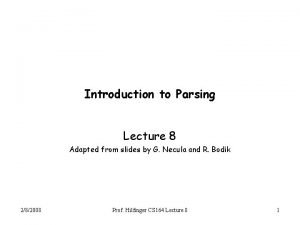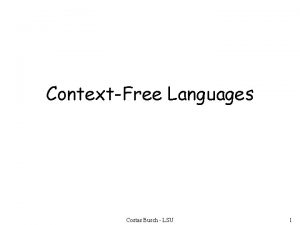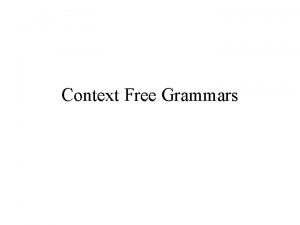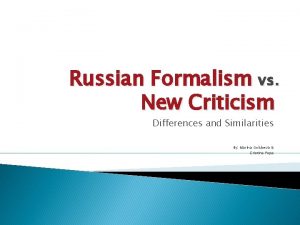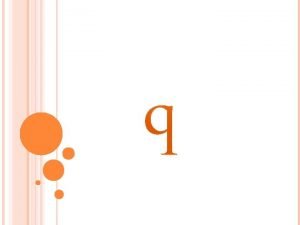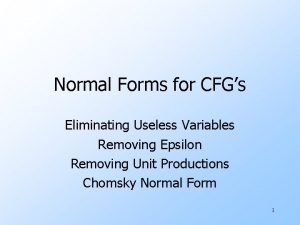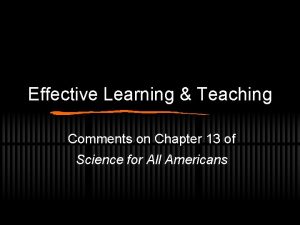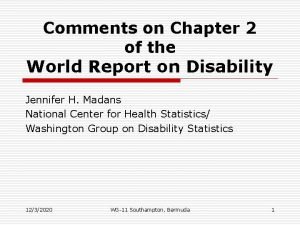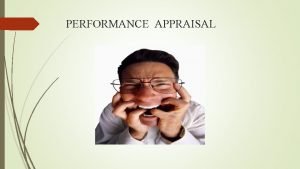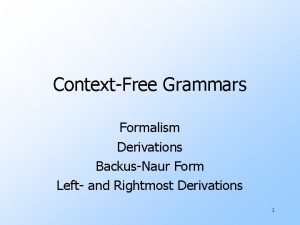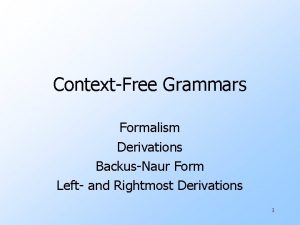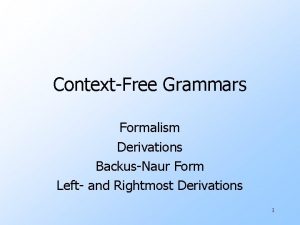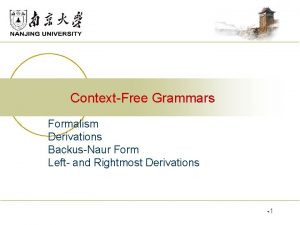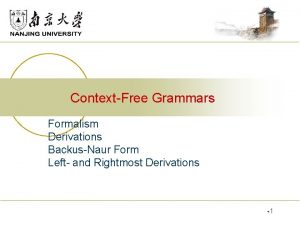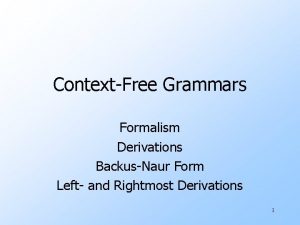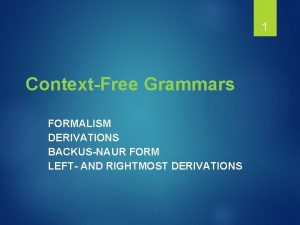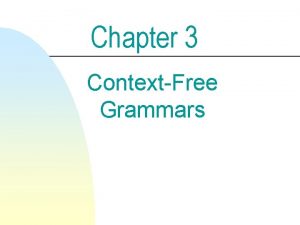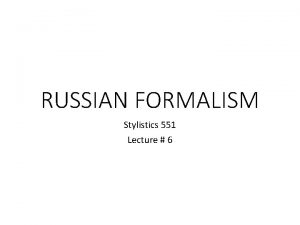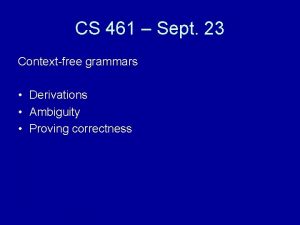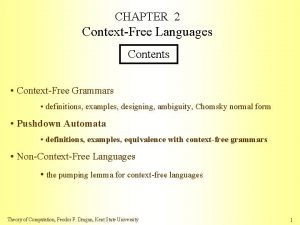Chapter 5 ContextFree Grammars Comments Formalism Derivations Leftmost















- Slides: 15

Chapter 5: Context-Free Grammars Comments Formalism Derivations Leftmost and Rightmost Derivations 1

Comments about CFGs • Context-free grammar: another way to define languages. • It is more powerful than finite automata or regular expressions • Played an important role in complier technology • Particularly parsers (functions that discover the structure of programs) 2

More comments about CFGs Two basis things to learn about CFGs: • How CFGs defines languages • How to derive the strings in those languages Use “variables” to stand for sets of strings. Define variables recursively Recursive rules are called “productions” 3

Example: CFG for { 0 n 1 n | n > 1} S is a variable Productions of S: S -> 01 S -> 0 S 1 Basis: 01 is in the language (n=1). Induction: if w is in the language, then 0 w 1 is in the language 4

CFG Formalism • Terminals = symbols of the alphabet of the language being defined. • Variables = a finite set of symbols, each of which represents a language (i. e. a set of strings) • Start symbol = the variable whose language is the one being defined. • Production = replacement rules of the form variable -> string of variables and terminals. 5

Formal CFG definitions Formal definition of the CFG for {0 n 1 n|n>1} Terminals: {0, 1} Variables: {S} Start symbol: S Productions: S->01|0 S 1 short-hand for S -> 01 S -> 0 S 1 6

Derivations We derive strings in the language of a CFG by starting with the start symbol, and repeatedly replacing some variable, A for example, by the right side of one of its productions. “productions of A” are replacement rules for A Derivation is complete when all variables are expressed as terminals Denote each step in a derivation by => Example : A => if A -> is a production 7

Examples of derivations: derive string 000111 in { 0 n 1 n | n > 1} Productions are S -> 01; S -> 0 S 1. 8

Examples of derivations: derive string 000111 in { 0 n 1 n | n > 1} Productions are S -> 01; S -> 0 S 1. S => 0 S 1 => 00 S 11 => 000111 Replace S by 0 S 1 as many times as needed Complete by replacing S by 01 9

Formal definition of L(CFG) S=> means “one derivation step of S” S=>* means “zero or more steps of S” Formal definition of L(CFG) on alphabet T L(CFG) = {w in T* | S =>* w} w must be a terminal string S must be the start symbol of derivation of w Not all CFL are regular Example: L = {0 n 1 n | n > 0} Not all languages are CFL’s. 10

Sentential Forms Any string of variables and/or terminals derived from the start symbol is called a sentential form. Formally, is a sentential form iff S =>*. 11

Leftmost and Rightmost Derivations allow us to replace any of the variables in a string. Leads to many different derivations of the same string. By forcing the leftmost variable (or alternatively, the rightmost variable) to be replaced, we avoid these “distinctions without a difference. ” 12

leftmost/rightmost notation w. A =>lm w using production A -> denotes a single leftmost step. =>*lm denotes zero or more leftmost steps by which becomes . Similarly for rightmost derivations 13

Example: Leftmost/Rightmost Derivations Balanced-parentheses grammar: S -> SS | (S) | () perform S =>*lm (())() perform S =>*rm (())() 14

Example: Leftmost/Rightmost Derivations Balanced-parentheses grammar: S -> SS | (S) | () perform S =>*lm (())() perform S =>*rm (())() S =>lm SS =>lm (S)S =>lm (())() S =>rm S() =>rm (S)() =>rm (())() 15
 Ecg 18 dérivations
Ecg 18 dérivations Leftmost derivation and rightmost derivation
Leftmost derivation and rightmost derivation Lsu
Lsu Leftmost derivation
Leftmost derivation Practical criticism and new criticism
Practical criticism and new criticism Unrestricted grammars
Unrestricted grammars Questions on context free grammar
Questions on context free grammar Which grammar generates regular language?
Which grammar generates regular language? Eliminate useless symbols
Eliminate useless symbols Chomsky hierarchy of grammars
Chomsky hierarchy of grammars Comments for chapter 13
Comments for chapter 13 Comments for chapter 2
Comments for chapter 2 Presenting yourself on the uc application
Presenting yourself on the uc application Tat appraisal comments
Tat appraisal comments Performance review for integrity
Performance review for integrity Npqh sponsor comments examples
Npqh sponsor comments examples

